阳光学业评价·英语·小学四年级上册·听力材料
阳光学业评价 英语 四年级下册 听力录音材料

阳光学业评价英语四年级下册听力录音材料第一单元Lesson 11. Listen and circle.Instructions: Listen to the recording and circle the correct answers.Question 1: What is the boy doing?(A) Reading a book. (B) Playing soccer. (C) W atching TV.Question 2: How many apples does the girl have?(A) Two. (B) Three. (C) Five.Question 3: What color is the cat?(A) Brown. (B) Black. (C) White.2. Listen and complete.Instructions: Listen to the recording and complete the sentences.1. I have _______ books.2. _______ is playing soccer.3. _______ is your dog? It's brown.Lesson 21. Listen and choose.Instructions: Listen to the recording and choose the correct answer.Question 1: What day is it today?(A) Monday. (B) Tuesday. (C) Thursday. Question 2: What fruit does Lucy like?(A) Apples. (B) Oranges. (C) Bananas. Question 3: How many carrots are there?(A) Four. (B) Six. (C) Eight.2. Listen and match.Instructions: Listen to the recording and match the words to the correct pictures.1. orange2. banana3. carrot4. apple第二单元Lesson 11. Listen and repeat.Instructions: Listen to the recording and repeat the words.1.pencil2.ruler3.eraser4.sharpener2. Listen and answer.Instructions: Listen to the recording and answer the questions.Question 1: What color is the pencil? Question 2: Where is the ruler?Question 3: How many erasers are there? Question 4: What is next to the sharpener?Lesson 21. Listen and choose.Instructions: Listen to the recording and choose the correct answer.Question 1: What is your favorite fruit?(A) Apples. (B) Bananas. (C) Strawberries. Question 2: What is your favorite color?(A) Red. (B) Blue. (C) Yellow.Question 3: How many chairs are there in the room?(A) Five. (B) Six. (C) Seven.2. Listen and complete.Instructions: Listen to the recording and complete the sentences.1. My favorite fruit is _______.2. The cat is _______.3. There are _______ chairs in the room.第三单元Lesson 11. Listen and circle.Instructions: Listen to the recording and circle the correct answers.Question 1: What is the boy doing?(A) Playing soccer. (B) Reading a book. (C) W atching TV.Question 2: What is the girl doing?(A) Drawing. (B) Riding a bike. (C) Cooking. Question 3: What color is the cat?(A) Brown. (B) Black. (C) White.2. Listen and complete.Instructions: Listen to the recording and complete the sentences.1. The boy is _______ in the park.2. I am _______ a picture.3. _______ is your dog? It's black.Lesson 21. Listen and choose.Instructions: Listen to the recording and choose the correct answer.Question 1: What is the weather like today? (A) Sunny. (B) Cloudy. (C) Rainy.Question 2: What animal does Lucy like?(A) Dogs. (B) Cats. (C) Birds.Question 3: How many flowers are there?(A) Three. (B) Five. (C) Seven.2. Listen and match.Instructions: Listen to the recording and match the words to the correct pictures.1. sun2. rain3. cloud4. flower以上是《阳光学业评价英语四年级下册听力录音材料》的内容。
四年级上英语作业本听力材料
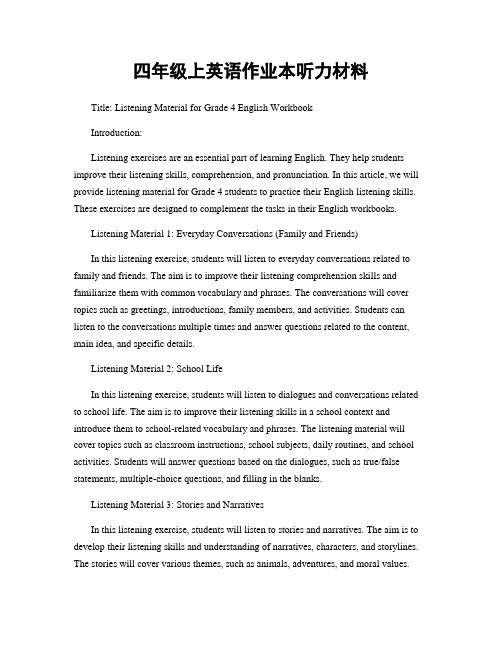
四年级上英语作业本听力材料Title: Listening Material for Grade 4 English WorkbookIntroduction:Listening exercises are an essential part of learning English. They help students improve their listening skills, comprehension, and pronunciation. In this article, we will provide listening material for Grade 4 students to practice their English listening skills. These exercises are designed to complement the tasks in their English workbooks.Listening Material 1: Everyday Conversations (Family and Friends)In this listening exercise, students will listen to everyday conversations related to family and friends. The aim is to improve their listening comprehension skills and familiarize them with common vocabulary and phrases. The conversations will cover topics such as greetings, introductions, family members, and activities. Students can listen to the conversations multiple times and answer questions related to the content, main idea, and specific details.Listening Material 2: School LifeIn this listening exercise, students will listen to dialogues and conversations related to school life. The aim is to improve their listening skills in a school context and introduce them to school-related vocabulary and phrases. The listening material will cover topics such as classroom instructions, school subjects, daily routines, and school activities. Students will answer questions based on the dialogues, such as true/false statements, multiple-choice questions, and filling in the blanks.Listening Material 3: Stories and NarrativesIn this listening exercise, students will listen to stories and narratives. The aim is to develop their listening skills and understanding of narratives, characters, and storylines. The stories will cover various themes, such as animals, adventures, and moral values.After listening to the stories, students will answer comprehension questions, identify the main characters, sequence events, and retell the story in their own words.Listening Material 4: Descriptions and InstructionsIn this listening exercise, students will listen to descriptions and instructions. The aim is to improve their listening skills and ability to follow instructions. The material will include descriptions of objects, people, and places, as well as instructions for tasks and games. Students will practice listening for specific information, identifying details, and understanding step-by-step instructions. They will be required to answer questions, complete tasks, and carry out instructions based on what they hear.Conclusion:Listening exercises are crucial for developing students' English language skills. The provided listening materials for Grade 4 English workbooks cover a range of topics, including everyday conversations, school life, stories, descriptions, and instructions. By regularly practicing these exercises, students can enhance their listening comprehension, vocabulary, and overall language proficiency. Remember, the key to effective listening is concentration, focus, and active engagement with the material.。
小学期末学业水平检测四年级上册英语试卷听力材料 20151
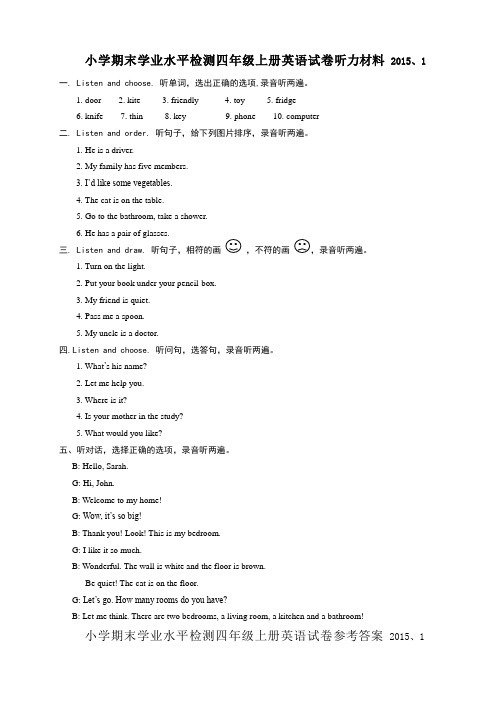
小学期末学业水平检测四年级上册英语试卷听力材料2015、1一. Listen and choose. 听单词,选出正确的选项,录音听两遍。
1. door2. kite3. friendly4. toy5. fridge6. knife7. thin8. key9. phone 10. computer二. Listen and order. 听句子,给下列图片排序,录音听两遍。
1. He is a driver.2. My family has five members.3. I’d like some vegetables.4. The cat is on the table.5. Go to the bathroom, take a shower.6. He has a pair of glasses.三. Listen and draw. 听句子,相符的画,不符的画1. Turn on the light.2. Put your book under your pencil-box.3. My friend is quiet.4. Pass me a spoon.5. My uncle is a doctor.四.Listen and choose. 听问句,选答句,录音听两遍。
1. What’s his name?2. Let me help you.3. Where is it?4. Is your mother in the study?5. What would you like?五、听对话,选择正确的选项,录音听两遍。
B: Hello, Sarah.G: Hi, John.B: Welcome to my home!G: Wow, it’s so big!B: Thank you! Look! This is my bedroom.G: I like it so much.B: Wonderful. The wall is white and the floor is brown.Be quiet! The cat is on the floor.G: Let’s go. How many rooms do you have?B: Let me think. There are two bedrooms, a living room, a kitchen and a bathroom!小学期末学业水平检测四年级上册英语试卷参考答案2015、1一. Listen and choose. 听单词,选出正确的选项。
四年级阳光学业评价答案上册英语2022

四年级阳光学业评价答案上册英语2022四年级阳光学业评价答案上册英语2022第一部分:听力1. 听数字This is the key to 2018.年的银钥匙,之前有个小女孩跟我问这个,我也不会,就在网上查了。
答案是3222。
2. 听选物品情景:Ben在超市买东西,他需要买一些水果和一些饼干,请帮忙选。
答案:Fruits: oranges, apples, bananasBiscuits: chocolate biscuits, oat biscuits, cream biscuits3. 听句子1) Who is taller, Tom or Jack? Answer: Tom.2) Do you like playing computer games? Answer: Yes, I do.3) What did you do yesterday? Answer: I watched TV.第二部分:语音1. 选出与其他三个单词发音不同的单词1) A. sheep B. ship C. shirt D. she答案:D2) A. chair B. chat C. chain D. child答案:C2. 找出划线部分发音不同于其他三个选项的单词1) A. b ea uty B. b ea n C. r ai n D. dr ea m答案:B2) A. m ove B. c ome C. n ose D. gr ove答案:D第三部分:词汇1. 根据句意及首字母提示写单词1) She can't f_______ the dictionary. Answer: find2) I have three s________ a day. Answer: meals3) They are t______ the ball. Answer: throwing2. 根据汉语提示写出英语单词1) 草地 Answer: grass2) 蔬菜 Answer: vegetables3) 起飞 Answer: take off第四部分:阅读理解1. 阅读理解Ted is a student. He goes to school from Monday to Friday. He likes playing basketball very much. He often plays basketball with his friends after school. He doesn't like playing the violin. But he has to learn it because his mother wants him to.根据短文内容回答下列问题:1) What does Ted like doing after school? Answer: He likes playing basketball after school.2) Does Ted like playing the violin? Answer: No, he doesn't like playing the violin.3) Why does Ted have to learn to play the violin? Answer: Because his mother wants him to.2. 阅读填空Tom is a boy. He is from England. He is eleven years old. He has a sister. Her name is Jane. She is eight years old. Tom has a cat. It is black and white. Tom likes playing football. He plays football with his friends after 答案: school1) How old is Tom? Answer: Tom is 11 years old.2) What is the name of Tom's sister? Answer: Tom's sister's name is Jane.3) What does Tom like doing? Answer: Tom likes playing football.第五部分:写作1. 写作题假如你是初中生,请写一篇介绍你爱好的短文。
阳光学业评价四年级上册英语

阳光学业评价四年级上册英语一、单词部分。
1. 重点单词。
- 按照单元分类整理课本中的重点单词,例如:- 第一单元可能涉及到的关于教室物品的单词:classroom(教室),desk(书桌),chair(椅子),blackboard(黑板)等。
- 第二单元关于人物身份的单词:teacher(教师),student(学生),pupil (小学生)等。
- 单词的记忆方法。
- 联想记忆法:如“blackboard”,可以联想黑色(black)的板子(board)就是黑板。
- 分类记忆法:把同类单词放在一起记忆,像学习动物单词时,cat(猫)、dog (狗)、bird(鸟)等可以一起记忆。
2. 单词的拼写和发音。
- 总结一些单词拼写的规律,例如:以“e”结尾的单词,“name”,“like”等,其中的元音字母通常发字母本身的音。
- 发音练习:可以通过简单的绕口令或者单词连读来练习发音,如“big black bag”。
二、句型部分。
1. 重点句型。
- 同样按单元整理,例如第一单元的“This is my classroom.”“I like my desk.”等。
- 句型的用法。
- 对于“This is...”句型,用于介绍某人或者某物,如“This is my teacher.”(这是我的老师)。
- “I like...”句型表达自己的喜好,后面可以接名词,如“I like my chair.”(我喜欢我的椅子)。
2. 句型转换。
- 肯定句、否定句和疑问句的转换。
- 例如:“I like my book.”(肯定句),否定句为“I don't like my book.”,一般疑问句为“Do you like your book?”- 特殊疑问句的构成,如对“my book”提问(事物),用“What”,即“What do you like?”三、语法部分。
1. 一般现在时。
- 概念:表示经常发生的动作或存在的状态。
四年级英语上听力材料
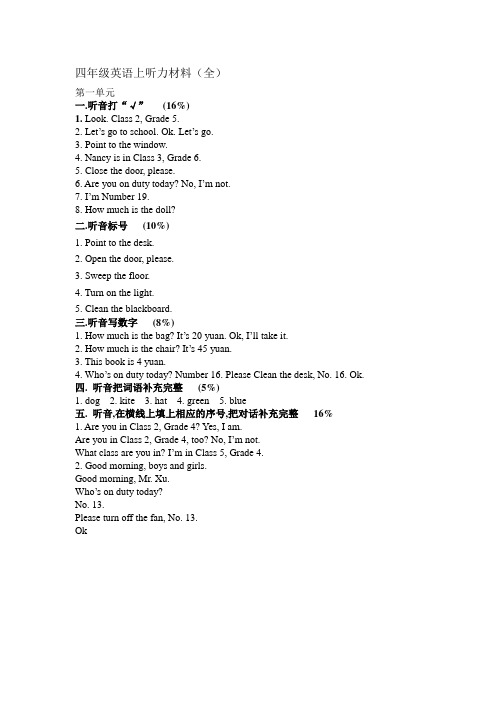
四年级英语上听力材料(全)第一单元一.听音打“√”(16%)1. Look. Class 2, Grade 5.2. Let’s go to school. Ok. Let’s go.3. Point to the window.4. Nancy is in Class 3, Grade 6.5. Close the door, please.6. Are you on duty today? No, I’m not.7. I’m Number 19.8. How much is the doll?二.听音标号(10%)1. Point to the desk.2. Open the door, please.3. Sweep the floor.4. Turn on the light.5. Clean the blackboard.三.听音写数字(8%)1. How much is the bag? It’s 20 yuan. Ok, I’ll take it.2. How much is the chair? It’s 45 yuan.3. This book is 4 yuan.4. Who’s on duty today? Number 16. Please Clean the desk, No. 16. Ok.四. 听音把词语补充完整(5%)1. dog2. kite3. hat4. green5. blue五. 听音,在横线上填上相应的序号,把对话补充完整16%1. Are you in Class 2, Grade 4? Yes, I am.Are you in Class 2, Grade 4, too? No, I’m not.What class are you in? I’m in Class 5, Grade 4.2. Good morning, boys and girls.Good morning, Mr. Xu.Who’s on duty today?No. 13.Please turn off the fan, No. 13.Ok一.听音打“√”(16%)1. It’s 10:00 in Beijing.2. When do you go to school? I go to school at 7:15.3. When do you go to bed?4. I have breakfast at 6:30.5. I like fish.6. It’s a sunny day.7. Look at the clouds in the sky. It’s raining.8. It’s cloudy in Hangzhou.二.听音标号(10%)1. I go home at 4:30 PM.2. Take an umbrella. It’s going to rain.3. I get up at 6:30 AM.4. We have dinner at 7:00 PM.5. I go to bed at 9:15 PM.三.听音写时间(8%)1. What’s the time? It’s eight thirty.2. What’s the time? It’s 12:00.3. When do you go home? I go home at five forty.4. It’s six ten o’clock Beijing time. It’s raining outside.四. 听音把词语补充完整(5%)1. book2. sheep3. peach4. fish5. zebra五. 听音,在横线上填上相应的序号,把对话补充完整16%A: What’s the time?B: It’s 7:00.A: I usually have breakfast at 7:00. Then I go to school.B: Excuse me. What do you usually have for breakfast? I usually have milk and eggs. B: When do you get home for lunch?A: I usually get home at 11:45. I have lunch at 12:00. I have rice, vegetables and fish. B: I like them, too!一.听音打“√”(16%)1. I like spring. It’s warm.2. It’s cool in fall.3. Birds sing and trees turn green in spring.4. We can make snowmen in winter.5. Wang Tao wears a T-shirt and shorts in summer.6. What present does Kate want? She wants a bike.7. What present do you want children? I want a computer, Santa.8. My mother puts the presents under the tree.二.听音标号(10%)How do you spend Chinese New Year? We make dumplings. We have a big dinner. Then we watch New Year programs on CCTV. On New Year’s Day, we say Happy New Year to each other and we go to the fair, too.三.听音连线(8%)1. What present do you want, Wang Tao? I want a new bag.2. What present does Hu Ping want? He wants a robot.3. What present does Chen Ling want? She wants a bike.4. What present do you want, Li Hong? I want a kite.四. 听音把词语补充完整(5%)1. horse2. summer3. cat4. coat5. father五. 听音,在横线上填上相应的序号,把对话补充完整16%Sally and Wang Tao are talking about Christmas.(莎丽和王淘正在谈论关于圣诞节的事情。
阳光学业评价四年级上册英语u10听力材料

阳光学业评价四年级上册英语u10听力材料In the world of education, the Sunshine Academic Evaluation for the fourth grade's upper semester English Unit 10 listening materials stands out as a comprehensive and engaging tool for enhancing student comprehension and language skills. The listening materials, carefully crafted to align with the educational standards, provide students with a platform to practice their listening comprehension and vocabulary retention.The listening section of Unit 10 covers a range of topics, including daily routines, school activities, and cultural exchanges. The dialogues and monologues are designed to be engaging and relevant, allowing students to connect with the content and apply their knowledge in real-world scenarios. The pace and difficulty of the listening materials are gradually increased, challenging students to improve their listening skills while maintaining their interest.One of the显著features of the Sunshine Academic Evaluation listening materials is its emphasis on culturalexchange. Through authentic dialogues and scenarios, students are exposed to a variety of cultural perspectives, encouraging them to develop a global mindset and appreciate the diversity of languages and cultures.To effectively utilize these listening materials, teachers can incorporate them into their daily lesson plans. Before the listening activity, teachers can introduce the relevant vocabulary and phrases to ensure students are familiar with the terminology. During the listening session, teachers can guide students through the material, asking questions and encouraging active participation. After the listening activity, teachers can provide feedback andclarify any misunderstandings, followed by additional practice activities to consolidate the learned content.Moreover, parents can also play a pivotal role in supporting their children's learning by discussing the listening materials at home. By asking questions about the dialogues and scenarios, parents can encourage critical thinking and foster a deeper understanding of the content. They can also create opportunities for their children topractice listening skills by engaging them in conversation and reading aloud.In conclusion, the Sunshine Academic Evaluation fourth grade upper semester English Unit 10 listening materials are a valuable resource for enhancing student comprehension and language skills. With its focus on cultural exchange and engagement, it prepares students to become global citizens with a strong foundation in language learning. By integrating these materials into the classroom andfostering a supportive learning environment at home, students can achieve their full potential in the field of language acquisition.**阳光学业评价四年级上册英语U10听力材料解析与应用** 在教育领域,阳光学业评价四年级上册英语U10的听力材料因其全面性和吸引力,成为提高学生理解和语言技能的有力工具。
阳光学业评价英语四年级下册听力录音材料

+%/?)0#
1+听问句三次 选择合适的答语
= H?,/':L0:H?'/)&'C) B H?)0)':@%20P6/),(?)0 D H?,/':@%207,5%20'/):2<R)(/ E H?,/I:@%202-(&)I:R%< F H?%I:/?)&,4@*'/? ,<,A
0+听句子三次 写出句子所缺的单词
= >?)0)':,&,4@%5)0/?)0)#1,- @%2 :)) ?)0
B V20-)*/),(?)0':5)0@C'-4# D L@<0%/?)0':/,&&,-4 /?'-# E J,(C ':,70')-4&@<%@# F L@+,/?:/),(?)0?,:,0%2-4 7,()# G >?)&'//&)A'0&'::?@# K L@(%2:'- ?,:,$,'0%7<'A)@):,-4 ,
.#,*%+,- *'/? ,0%2-4 7,(),-4 :+,&&)@):
1#,*%+,- '- ,:*),/)0,-4 R),-: 3#,&,4@*'/? :%+)<%%C: 6#,*%+,- *'/? ,<,<@
四年级上册英语阳光学业评价1到14页

四年级上册英语阳光学业评价1到14页随着学生年级的逐渐增加,学业评价的重要性也逐渐凸显出来。
而英语作为一门重要的学科,其学业评价更是备受重视。
本文将对四年级上册英语阳光学业评价1到14页进行系统的分析和总结,以期为学生、家长和教育工作者提供借鉴和参考。
一、评价方式多样化在四年级上册英语阳光学业评价中,评价方式呈现出多样化的特点。
不仅包括书面作业、听力测试、口语表现等传统评价方式,还包括课堂参与度、小组合作表现等综合评价方式。
这种多样化的评价方式有利于全面了解学生的英语水平,促进其全面发展。
二、注重基础知识和技能的掌握评价内容主要围绕基础知识和技能展开,例如英语单词、词组、句型的掌握情况,阅读和听力能力的提高情况等。
通过对这些评价内容的分析,可以发现学生在语言基础方面存在哪些问题,从而有针对性地进行教学辅导和提高。
三、突出语言运用能力与传统的英语学业评价不同的是,四年级上册英语阳光学业评价更加注重学生的语言运用能力。
评价内容中不仅有对基础知识的考察,还包括了学生在实际情境中运用英语进行交流的能力。
这无疑更加符合英语教学的实际需求,也更有利于培养学生的语言实际运用能力。
四、评价结果客观准确四年级上册英语阳光学业评价所得出的评价结果客观准确。
评价过程中注重考察学生的实际表现和能力,避免了片面主观的评价结果。
这毫无疑问是对学生学业真实水平的客观反映,也是对教育教学质量的客观检验。
五、评价结果反馈及时评价结果反馈及时是评价工作的重要环节。
四年级上册英语阳光学业评价所得出的评价结果可以及时反馈给学生和家长,以便及时发现问题并加以解决。
及时的反馈也有利于教师及时调整教学方案,提高教学效果。
六、评价成绩合理分布在四年级上册英语阳光学业评价中,评价成绩呈现出较为合理的分布。
既有成绩优秀的学生,也有成绩一般和较差的学生,这样的分布体现了评价的客观性和公正性。
也有利于激发学生学习的积极性,促进他们的进步和提高。
四年级上册英语阳光学业评价1到14页的评价结果客观准确,反馈及时有效,具有一定的指导意义。
英语阳光学业评价四年级上册听力

英语阳光学业评价四年级上册听力在孩子们的学习旅程中,英语听力是一项至关重要的技能。
为了帮助四年级的学生们提升这一技能,我们精心设计了《英语阳光学业评价四年级上册听力》这一课程。
本课程旨在通过系统的听力训练,培养孩子们的听力理解能力,使他们能够自信地应对各种英语听力场景。
一、课程目标《英语阳光学业评价四年级上册听力》的课程目标主要包括:提高孩子们的听力理解能力,培养他们的语音敏感度,增强他们的语感,以及提升他们的口语表达能力。
通过本课程的学习,孩子们将能够更好地理解和运用英语,为将来的英语学习打下坚实的基础。
二、课程内容课程内容丰富多样,涵盖了各种听力场景,如日常生活、学校生活、文化交流等。
每个单元都会通过听力理解、口语表达、阅读理解和写作等环节,全面提升孩子们的英语综合能力。
此外,我们还设置了专门的语音训练模块,帮助孩子们掌握正确的发音和语调。
三、教学方法本课程采用互动式教学法,注重孩子们的参与和互动。
我们通过有趣的听力游戏、角色扮演、小组讨论等形式,激发孩子们的学习兴趣,使他们能够在轻松愉快的氛围中学习英语。
同时,我们还会定期进行反馈和评估,帮助孩子们了解自己的进步,及时调整学习策略。
四、评价方式为了确保教学效果,本课程采用多元化的评价方式。
除了传统的笔试外,我们还注重口语表达和听力理解能力的评估。
孩子们需要展示他们的听说读写综合能力,才能获得相应的学分。
这种评价方式能够真实反映孩子们的学习成果,并为他们的后续学习提供指导。
五、总结总的来说,《英语阳光学业评价四年级上册听力》是一套系统、全面、有趣的英语听力课程。
它旨在通过科学的训练方法,帮助孩子们提升英语听力技能,培养他们的英语综合能力。
通过本课程的学习,孩子们将能够更好地理解和运用英语,为将来的英语学习打下坚实的基础。
在未来的学习中,我们还将不断优化课程内容和方法,以满足孩子们日益增长的学习需求。
我们相信,《英语阳光学业评价四年级上册听力》将成为孩子们学习英语的一把金钥匙,带领他们走向更广阔的知识天地。
四年级上册英语学业评价答案

四年级上册英语学业评价期末测试答案一、听力部分(40分)一、Listen and choose.圈出你所听到的单词。
(10分)1.Let me clean the door / floor.2.Where is the fridge / friend?3.Look! They are on the shelf / sofa.4.Pass me the plate / knife, please.5.Is she in the kitchen / chicken?6.Can I have some hot dogs / hamburgers, please?7.My uncle / aunt is a teacher / doctor.8.--How many Chinese books / English books can you see?--I can see forty / fifty.二、Listen and order.听录音,为下列图片排序。
(10分)( ) ( ) ( ) ( ) ( )三、Listen and choose the answers.听问句,选择答句。
(10分)( ) 1. A. Some books and toys. B. My schoolbag is heavy.( ) 2. A. He is my friend. B. He has blue glasses.( ) 3. A. No, they aren’t. B. Yes, it is.( ) 4. A. I like some beef. B. Some beef.( ) 5. A. She’s a doctor. B. He’s a doctor.四、Listen and judge.判断下列句子与听到的是否相同,相同的打“√”,不相同的打“×”。
(10分)( ) 1.It’s not mine, it’s yours.( ) 2. She’s got a black book.( ) 3. Can you ask me a question?( ) 4. That hat is his.( ) 5. My hair is short, but hers is long.二、笔试部分(57分)一、Read and choose. 选出划线部分发音不同的单词。
阳光试卷听力四年级【含答案】

阳光试卷听力四年级【含答案】专业课原理概述部分一、选择题(每题1分,共5分)1. 下列哪种情况不属于听力障碍?A. 耳朵疼痛B. 分辨声音困难C. 耳鸣D. 听力丧失2. 声音的频率单位是?A. 分贝B. 赫兹C. 瓦特D. 秒3. 下列哪种因素可能影响听力?A. 噪音暴露B. 年龄C. 遗传D. 所有上述因素4. 助听器的主要功能是什么?A. 改善视力B. 放大声音C. 治疗耳疾D. 提高语言理解能力5. 下列哪种听力测试方法用于评估儿童的语言理解能力?A. 纯音测听B. 言语识别测试C. 耳鸣测试D. 鼓室图二、判断题(每题1分,共5分)1. 听力丧失是一种常见的感官障碍。
(√)2. 噪音水平高于85分贝可能导致听力损害。
(√)3. 助听器可以治愈所有类型的听力障碍。
(×)4. 儿童的听力问题通常在出生后不久就能被诊断出来。
(√)5. 听力康复包括医疗和手术治疗。
(×)三、填空题(每题1分,共5分)1. 声音的高低称为______。
2. 声音的强弱称为______。
3. 常见的听力障碍包括______、______和______。
4. 听力康复的目的是帮助患者______、______和______。
5. 儿童听力筛查通常在出生后的______天内进行。
四、简答题(每题2分,共10分)1. 简述听力障碍的主要原因。
2. 解释听力康复的重要性。
3. 描述听力测试的基本方法。
4. 说明儿童听力问题对语言发展的影响。
5. 讨论噪音对听力的影响。
五、应用题(每题2分,共10分)1. 某学生的听力测试结果显示,他在4000赫兹的频率下听力损失了40分贝。
请问这是什么类型的听力障碍?如何建议他进行听力康复?2. 一位60岁的老人在嘈杂环境中经常听不清别人说话。
请问可能的原因是什么?建议他进行哪些听力测试?3. 一名儿童在幼儿园的听力筛查中被发现有听力问题。
请问应该进行哪些评估和干预措施?4. 一位音乐家长期暴露在高分贝的音乐环境中,出现了耳鸣和听力下降。
阳光评价四年级上册英语答案
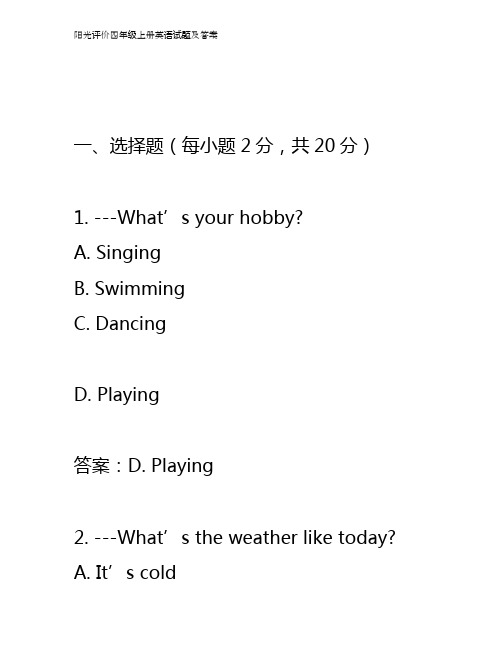
一、选择题(每小题2分,共20分)1. ---What’s your hobby?A. SingingB. SwimmingC. DancingD. Playing答案:D. Playing2. ---What’s the weather like today?A. It’s coldB. It’s sunnyC. It’s cloudyD. It’s hot答案:B. It’s sunny3. ---What do you like to do in your free time?A. Play sportsB. Watch TVC. Read booksD. Listen to music答案:A. Play sports4. ---What’s your favorite food?A. RiceB. NoodlesC. FishD. Pizza答案:D. Pizza5. ---What’s your favorite color?A. RedB. GreenC. BlueD. Yellow答案:A. Red6. ---What’s your favorite animal?A. CatB. DogC. RabbitD. Bear答案:B. Dog7. ---What do you want to be when yougrow up?A. TeacherB. DoctorC. ScientistD. Engineer答案:C. Scientist8. ---What do you like to do in summer?A. SkiingB. SwimmingC. SkatingD. Hiking答案:B. Swimming9. ---What do you like to do in winter?A. CyclingB. SkatingC. HikingD. Swimming答案:B. Skating10. ---What’s your favorite season?A. SpringB. SummerC. AutumnD. Winter答案:C. Autumn二、填空题(每小题2分,共20分)1. I like to ___________ in the park.答案:play2. I like to ___________ in the summer. 答案:swim3. I like to ___________ in the winter. 答案:skate4. I like to ___________ in the autumn. 答案:hike5. I like to ___________ in the spring. 答案:cycle6. I like to ___________ in my free time.答案:read7. I like to ___________ with my friends. 答案:chat8. I like to ___________ after school.答案:play9. I like to ___________ on the weekends. 答案:go out10. I like to ___________ on the computer.答案:play games三、完形填空(每小题2分,共20分)I have a good friend. His name is John. He is 1 . He likes to play basketball and he is very good at it. He often plays basketball with his friends 2 the weekend. He likes to watch movies, too. He 3 to watch action movies. He also likes to 4 music. He listens to music every day. He 5 different kinds of music.John is a very 6 person. He often helpshis classmates with their studies. He 7 his friends with their homework. He is always 8 to help others. He is also very9 . He likes to make people laugh. He often tells jokes and makes everyone 10 .1. A. tall B. short C. strong D. handsome答案:A. tall2. A. in B. at C. on D. for答案:C. on3. A. likes B. wants C. needs D. loves答案:A. likes4. A. listen B. hear C. sing D. play答案:A. listen5. A. likes B. loves C. listens D. hears 答案:C. listens6. A. kind B. friendly C. happy D. funny 答案:A. kind7. A. helps B. teaches C. studies D. speaks答案:A. helps8. A. happy B. willing C. sad D. angry答案:B. willing9. A. funny B. serious C. kind D. helpful答案:A. funny10. A. laugh B. cry C. smile D. shout答案:A. laugh四、阅读理解(每小题2分,共20分)Tom is a student. He is twelve years old. He likes sports very much. He often plays football with his friends in the park. He also likes to play basketball and ride a bike.Tom likes music, too. He likes to listen to music and play the guitar. He often sings songs with his friends.Tom also likes to read books. He likes toread books about animals and nature. He likes to learn new things from books.Tom is a good student. He always works hard at school. He is good at math and science.1. How old is Tom?答案:Twelve years old.2. What does Tom like to do?答案:He likes to play sports, listen tomusic, play the guitar, read books, and study hard.。
阳光试卷听力四年级
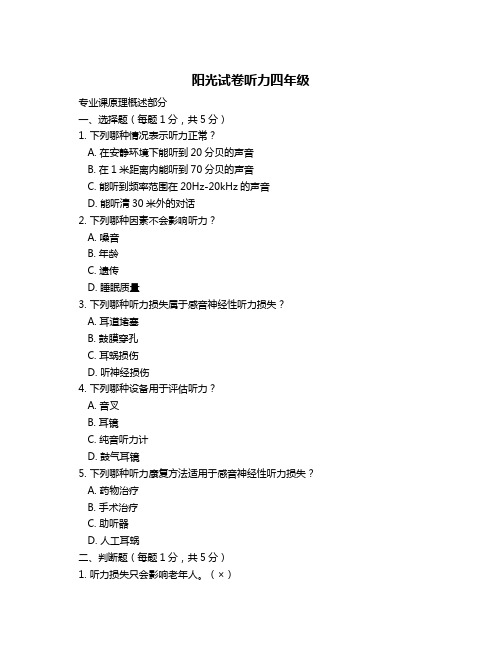
阳光试卷听力四年级专业课原理概述部分一、选择题(每题1分,共5分)1. 下列哪种情况表示听力正常?A. 在安静环境下能听到20分贝的声音B. 在1米距离内能听到70分贝的声音C. 能听到频率范围在20Hz-20kHz的声音D. 能听清30米外的对话2. 下列哪种因素不会影响听力?A. 噪音B. 年龄C. 遗传D. 睡眠质量3. 下列哪种听力损失属于感音神经性听力损失?A. 耳道堵塞B. 鼓膜穿孔C. 耳蜗损伤D. 听神经损伤4. 下列哪种设备用于评估听力?A. 音叉B. 耳镜C. 纯音听力计D. 鼓气耳镜5. 下列哪种听力康复方法适用于感音神经性听力损失?A. 药物治疗B. 手术治疗C. 助听器D. 人工耳蜗二、判断题(每题1分,共5分)1. 听力损失只会影响老年人。
(×)2. 噪音是导致听力损失的主要原因之一。
(√)3. 耳鸣是听力损失的前兆。
(×)4. 助听器可以治愈所有类型的听力损失。
(×)5. 定期进行听力检查有助于早期发现听力问题。
(√)三、填空题(每题1分,共5分)1. 听力损失分为两大类:传导性听力损失和______听力损失。
2. 正常听力范围是______Hz到______kHz。
3. 耳朵分为三个部分:外耳、中耳和______。
4. 听力损失的常见原因包括噪音、年龄、遗传和______。
5. 听力康复方法包括药物治疗、手术治疗、助听器和______。
四、简答题(每题2分,共10分)1. 请简述听力损失的定义及其影响。
2. 请列举三种常见的听力损失原因。
3. 请解释传导性听力损失和感音神经性听力损失的区别。
4. 请简述听力康复的重要性及其方法。
5. 请说明如何预防听力损失。
五、应用题(每题2分,共10分)1. 小明在噪音环境下工作多年,最近发现听力下降。
请分析可能的原因并提出合理的听力康复建议。
2. 一位60岁老人在电话通话时总是听不清对方说话。
请分析可能的原因并提出合理的听力康复建议。
阳光学业评价·英语·四年级上册·听力材料
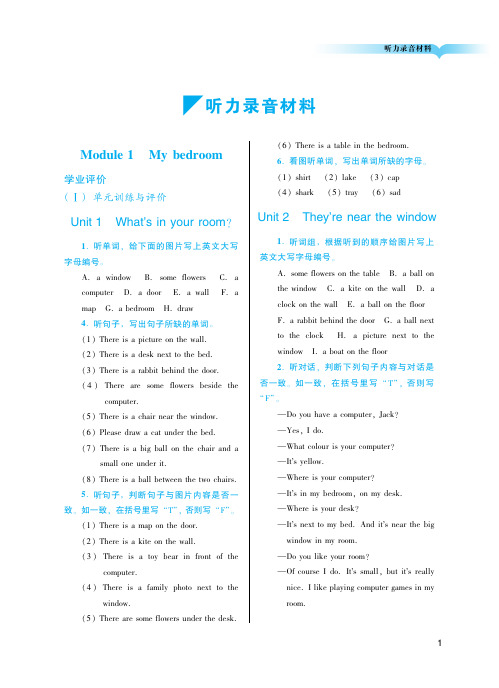
!"#$%&0(!) 2"$3&
!"#$
!"#$6&'378-03$-0, (-.+3
'"%&' ()*+,-.56 #"/&L&'H0)),! *"@&52>-' ! 1"+54(J! 6"5)&/-5!7"H$0(-'!8":-(0)), 0"%78 <=%N+78>,ABC D ECD FG6H. = BI. 8 < =>-0-$0-.&L-0)),+&' 5>&+>)4+-" ? =>&+&+$:&H@&52>-'" B =>&+>)4+->$+$H$0(-'" C =>-5)&/-5&+2/-$'" D =>-0-$0-+),-./)%-0+:-5%--' 5>-5%)
@&52>-'" E S-5P+H0)%+),-./)%-0+&' 5>-H$0(-'" G =>-:$5>0)),&+2/-$'" I O>-0-()J)4 >$L-,-$/+
'"%TX Uca+defgaVW+ h:ij
小学四年级上册英语期末学业水平调研(含听力材料)
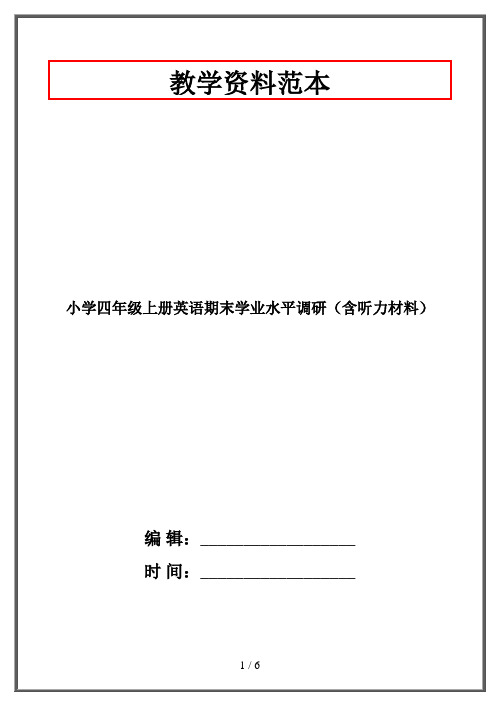
5.you, would, like, what(?)___________________________________
九、阅读短文,判断正误。正确的用“T”表示,错误的用“F”表示。(10分)
( )15.—Can you see the boythe tree? —Yes ,I can.
A.with B. in C. on
七、从II栏中找出I栏相应的答句,写在题前的括号内。(5’)
( )1.Where are my white caps?A. Thirteen.
()2.How many toy pandas do you have?B. It’s five yuan.
1. A:What’s this, Jack?
B: It’s my playhouse(玩具屋)
A: Are these toys?
B: Yes, they are all new. Look, I have ten cars.
A: They are beautiful. How many balls do you have?
6、aglassof milk7、forty-five8、Do you like mangoes?
9、What would you like?10、Can you swim?
二、听录音,选择正确的答句。(读两遍)(10’)
1、Can you play basketball?
2、How many grapesdoyou have ?
—Twenty yuan.
2. — Let’s go swimming.
人教版四年级上册阳光课堂听力

人教版四年级上册阳光课堂听力一、自然环境感知在阳光课堂听力中,学生将通过听力材料了解和感知自然环境。
他们将听到关于动植物、天气、地理等方面的内容,例如描述季节变化、动植物习性、自然灾害等。
通过这种方式,学生将更加关注周围环境,培养对大自然的热爱和保护意识。
二、人文历史了解在阳光课堂听力中,学生还将了解一些关于人文历史的知识。
他们将听到关于传统节日、历史人物、文化遗产等方面的内容,例如讲述著名历史事件、杰出人物的事迹等。
通过这些内容,学生将更加深入地了解和尊重人类历史和文化,培养人文素养和社会责任感。
三、日常会话交流阳光课堂听力注重培养学生的实际语言运用能力。
在听力材料中,将模拟日常生活中的情景对话,涉及问候、介绍、购物、问路等话题。
通过这些对话,学生将学习如何在真实语境中运用英语进行交流,提高口语表达能力。
四、学科知识拓展阳光课堂听力还注重与其他学科的整合,帮助学生拓展知识面。
听力材料将涵盖科学、数学、艺术等学科领域,例如介绍科学实验、数学问题、音乐和美术等方面的内容。
通过这些听力材料,学生将学习跨学科的知识,培养综合素质和创新精神。
五、听说技能训练阳光课堂听力注重培养学生的听说技能。
在听力训练中,学生将通过听对话或短文,完成填空、选择、判断等题型,提高听力和理解能力。
同时,他们还将通过模仿和跟读等练习,培养正确的语音和语调,提高口语表达能力。
六、语言知识掌握阳光课堂听力还将注重语言知识的掌握。
学生将在听力材料中学习单词、短语、句型等语言知识,并通过听力练习和阅读理解等题型巩固所学内容。
通过不断积累和运用语言知识,学生将打下坚实的英语基础,提高语言综合运用能力。
- 1、下载文档前请自行甄别文档内容的完整性,平台不提供额外的编辑、内容补充、找答案等附加服务。
- 2、"仅部分预览"的文档,不可在线预览部分如存在完整性等问题,可反馈申请退款(可完整预览的文档不适用该条件!)。
- 3、如文档侵犯您的权益,请联系客服反馈,我们会尽快为您处理(人工客服工作时间:9:00-18:30)。
!"#$%&0(!) 2"$3&
!"#$
!"#$6&'378-03$-0, (-.+3
'"%&' ()*+,-.56 #"/&L&'H0)),! *"@&52>-' ! 1"+54(J! 6"5)&/-5!7"H$0(-'!8":-(0)), 0"%78 <=%N+78>,ABC D ECD FG6H. = BI. 8 < =>-0-$0-.&L-0)),+&' 5>&+>)4+-" ? =>&+&+$:&H@&52>-'" B =>&+>)4+->$+$H$0(-'" C =>-5)&/-5&+2/-$'" D =>-0-$0-+),-./)%-0+:-5%--' 5>-5%)
#'( 5>$5=R)' 5>-%$//&+0-$//J:&H" 1),-$'( >$L-$/))@ $5,J:-(0))," O)% J)40:-(0)),&+3403/-"K/)L-&5" 6)J)4 %$'55)3/$JH$,-+ K>$L-$'-%
2),345-0"S))@ &5P+)' 5>-./))0" 90-$5 S-5P+3/$JH$,-+"
5>-2),345-00))," 1"%78 .978:;+&' < S-5,-+>)%J)4 ,J'-%2/$++0))," ? K+5>-0-$HJ,&' J)40+2>))/ B K+),-5&,-+-$5$55>-+2>))/P+(&'&'H
!"#$1&2(3,*/3"3)/$(34#"5-4
'"%'K LM%N+OP(,-./ 012.3456
#"+),-./)%-0+)' 5>-5$:/-!*"$:$//)' 5>-%&'()%! 1"$@&5-)' 5>-%$//! 6"$ 2/)2@ )' 5>-%$//!7"$:$//)' 5>-./))0! 8"$0$::&5:->&'( 5>-())0!9"$:$//'-A5 5)5>-2/)2@ ! ;" $3&2540-'-A55)5>%&'()%!K"$:)$5)' 5>-./))0! 0"%QR <=)S78?@>QRA BCD ECD FG6H. = BI. 8 6)J)4 >$L-$2),345-0 M$2@ N-+ K()" O>$52)/)40&+J)402),345-0 K5P+J-//)%" O>-0-&+J)402),345-0 K5P+&' ,J:-(0)), )' ,J(-+@" O>-0-&+J)40(-+@ K5P+'-A55),J:-("#'( &5P+'-$05>-:&H
#"$+).$!*"$2),345-0!1"$./))0 6"$2/)2@!7"$./)%-0!8"$,$3 9"$%&'()%!;"(0$% 0"J, <=%N+78>,+?@AB CD ECD FG6H. = BI. 8 < =>-0-&+$:$//:->&'( 5>-())0" ? =>-2),345-0&+)' 5>-:-(" B =>-=R&+&' .0)'5).5>-(-+@" C =>-0-$0-'P5$'J:))@+)' 5>-./))0" D =>-2/)2@ &+'-A55)5>-2),345-0" E =>-0-&+$,$3 )' 5>-%$//" 1"%78 .978:;+&' < K+5>-()H&' J)40:-(0)), ? K%$'55):4J+),-:$'$'$+')%" B 6)'P5)3-' J)40-J-+" C F/-$+-(0$%$2),345-0>-0-" D =>-0-&+$3&'@ :$//&' 5>-%>&5-:)A" E =>$52>&/( &+5$//" -"%T7 \]^_+XY < O>$5&+)' 5>-5$:/- ? K+5>-0-$2/)2@ )' 5>-%$// B O>)+-@&5-&+5>$5 C O>-0-&+5>-2/)2@ D ;)%,$'J5)J+$0-5>-0-&' 5>&+0)),
? K/)L-5>-2)/)40).5>-%$//+" B O>$5:4&/(&'H&+5>$5)L-05>-0- C 6)J)4 /&L-%&5> J)404'2/-$'( $4'5 D Q40+2>))/&+/$0H-" E =>-5)&/-5&++,$// :45&5&+2/-$'" G U+O>&5-&+')5&' 5>-./$5"V>-P+$5
#"5$@-$+>)%-0!*">$L-$,-$/ 1"%$52> =R! 6"0-$( :))@+! 7"(),J >),-%)0@!8"H0)%./)%-0+ 0"%78 LM%N+?@(,-.b 356 < K0-$( :))@+)' 5>-:-( &' 5>&+0))," ? K5$@-$+>)%-0&' 5>&+0))," B K%$52> =R&' 5>&+0))," C =>-0-$0-,$'J./)%-0+>-0-" D O->$L-,-$/+>-0-"
E K+5>-2>$&0&' 5>-H$0(-' T) &5P+&' 5>-5)&/-5"
0"%78 Uga+defca+h: ij
K(0$%3&2540-+&' 5>-H$0(-'" K0-$( :))@+&' 5>-5)&/-5" K3/$J2),345-0H$,-+&' 5>-+54(J" K%$52> =R&' 5>-/&L&'H0))," K>$L-,-$/+&' 5>-@&52>-'" K(),J>),-%)0@ &' ,J:-(0))," 1"%78 .978:;+&' < =>$5&+U01>-'P+>)4+-"
? O>-0-&+5>-+).$ K5P+&' 5>-:-(0)),"
